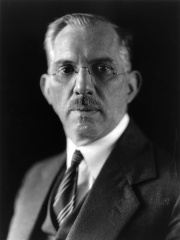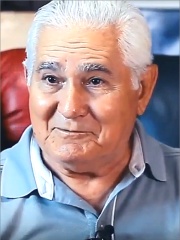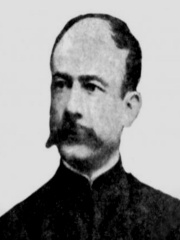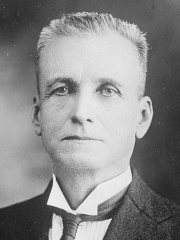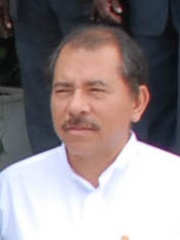
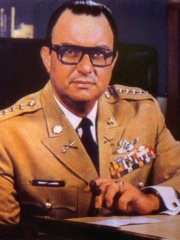
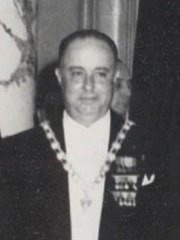
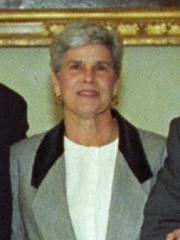
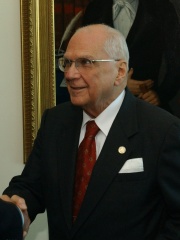
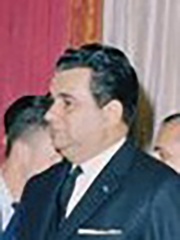
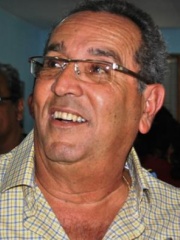
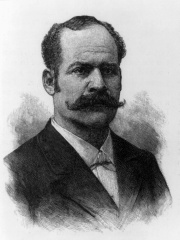
The Most Famous
POLITICIANS from Nicaragua
This page contains a list of the greatest Nicaraguan Politicians. The pantheon dataset contains 19,576 Politicians, 17 of which were born in Nicaragua. This makes Nicaragua the birth place of the 120th most number of Politicians behind Uganda, and Sudan.
Top 10
The following people are considered by Pantheon to be the top 10 most legendary Nicaraguan Politicians of all time. This list of famous Nicaraguan Politicians is sorted by HPI (Historical Popularity Index), a metric that aggregates information on a biography's online popularity. Visit the rankings page to view the entire list of Nicaraguan Politicians.

1. Daniel Ortega (b. 1945)
With an HPI of 76.59, Daniel Ortega is the most famous Nicaraguan Politician. His biography has been translated into 87 different languages on wikipedia.
José Daniel Ortega Saavedra ( or-TAY-gə, Spanish: [daˈnjel oɾˈteɣa]; born 11 November 1945) is a Nicaraguan politician who has been the co-president of Nicaragua since 18 February 2025, alongside his wife Rosario Murillo. He was the president of Nicaragua from 1985 to 1990 and from 2007 to 2025. He previously led Nicaragua as the first coordinator of the Junta of National Reconstruction from 1979 to 1985. Ortega leads an authoritarian government, and has been regularly described as a dictator by the international community. Ortega came to prominence with the overthrow and exile of US-backed dictator Anastasio Somoza Debayle in 1979 during the Nicaraguan Revolution. As a leader in the Sandinista National Liberation Front (Spanish: Frente Sandinista de Liberación Nacional, FSLN) Ortega became leader of the ruling Junta of National Reconstruction. A Marxist–Leninist, Ortega pursued a program of nationalization, land reform, wealth redistribution, and literacy programs during his first period in office. Ortega's government was responsible for the forced displacement of 10,000 indigenous people. In 1984, Ortega won Nicaragua's presidential election with over 60% of the vote as the FSLN's candidate. During his first term, he implemented policies to achieve leftist reforms across Nicaragua. Throughout the 1980s, Ortega's government faced a rebellion by US-backed rebels, known as the Contras. After a presidency marred by conflict and economic collapse, Ortega was defeated in the 1990 Nicaraguan general election by Violeta Chamorro. Ortega was an unsuccessful presidential candidate in 1996 and 2001 but won the 2006 Nicaraguan general election. In office, he allied with fellow Latin American socialists. In contrast to his previous political career, his second administration abandoned most of his earlier leftist principles, alienating many of his former revolutionary allies. Under his tenure, Nicaragua has experienced democratic backsliding. In June 2018, organizations such as Amnesty International and the Organization of American States reported that Ortega had engaged in a violent oppression campaign against anti-government protests. The violent crackdown and subsequent constriction of civil liberties have led to waves of emigration to neighboring Costa Rica, with more than 30,000 Nicaraguans filing for asylum in that country. His government jailed many potential rival candidates in the 2021 Nicaraguan general election, including Cristiana Chamorro Barrios. Ortega's government also imprisoned other opponents, such as former allies Dora María Téllez and Hugo Torres Jiménez. In August 2021, Nicaragua cancelled the operating permits of six US and European NGOs. Many critics of the Ortega government, including opposition leaders, journalists and members of civil society, fled the country in mid-2021. In his fourth term, Ortega ordered the closure of several NGOs, universities, and newspapers, and resumed his repression of the Catholic Church after a brief rapprochement, imprisoning prelate Rolando José Álvarez Lagos.

2. Anastasio Somoza Debayle (1925 - 1980)
With an HPI of 70.58, Anastasio Somoza Debayle is the 2nd most famous Nicaraguan Politician. His biography has been translated into 47 different languages.
Anastasio "Tachito" Somoza Debayle (Spanish: [anasˈtasjo soˈmosa ðeˈβajle]; 5 December 1925 – 17 September 1980) was a Nicaraguan politician who served as the 53rd President of Nicaragua from 1967 to 1972 and again from 1974 to 1979. As head of the National Guard, he was de facto ruler of the country between 1967 and 1979, even during the period when he was not the de jure ruler. Somoza Debayle succeeded his older brother, Luis Somoza Debayle, in office. He was the last member of the Somoza family to be president, ending a dynasty that had been in power since 1937. After insurgents led by the Sandinista National Liberation Front (Spanish: Frente Sandinista de Liberación Nacional; FSLN) were closing in on Managua in July 1979, Somoza fled Nicaragua. Power was ceded to the Junta of National Reconstruction. He was assassinated in 1980 while in exile in Paraguay.

3. Anastasio Somoza García (1896 - 1956)
With an HPI of 69.45, Anastasio Somoza García is the 3rd most famous Nicaraguan Politician. His biography has been translated into 39 different languages.
Anastasio Somoza García (1 February 1896 – 29 September 1956) was the leader of Nicaragua from 1936 until his assassination in 1956. He was officially the 21st President of Nicaragua from 1 January 1937 to 1 May 1947 and from 21 May 1950 until his assassination on 29 September 1956, ruling for the rest of the time as an unelected military dictator. He was the patriarch of the Somoza family, which ruled Nicaragua as a family dictatorship for 42 years. The son of a wealthy coffee planter, Somoza was educated in the United States. After his return to Nicaragua, he helped oust President Adolfo Díaz. He became the foreign secretary and took the title of "General". With the help of the U.S. Marine Corps, which occupied Nicaragua at the time, Somoza became the head of the National Guard. This gave him the power base to remove his wife's uncle, Juan Bautista Sacasa, from the presidency, and make himself president in 1937. In 1947, an ally nominally succeeded him, but he retained power. A month after his successor had been inaugurated, Somoza used the military to carry out a coup. The president was declared "incapacitated" by Congress and Somoza served in his stead. Returning to power in his own name in 1950, he maintained an iron grip on his own Nationalist Liberal Party while making a deal with the Conservatives; as a result, he faced no opposition. This left him free to amass a huge personal fortune. On 21 September 1956, Somoza was shot by poet Rigoberto López Pérez. Mortally wounded, he was flown to the Panama Canal Zone where he died a week later. His eldest son Luis Somoza Debayle, who was speaker of the House at the time of Somoza's death, took over as acting president and was elected in his own right in 1957. He served as president until 1963, and as the power behind puppet presidents until his death in 1967. Somoza's youngest son, Anastasio Somoza Debayle, was elected to serve until 1972, then served as the real power behind a nominally bipartisan junta until being reelected in 1974. Somoza Debayle was forced to resign in 1979 and was assassinated in exile in Paraguay the following year.

4. Violeta Chamorro (1929 - 2025)
With an HPI of 68.69, Violeta Chamorro is the 4th most famous Nicaraguan Politician. Her biography has been translated into 53 different languages.
Violeta Barrios Torres de Chamorro (Spanish pronunciation: [bjoˈleta ˈβarjos ˈtores de tʃaˈmoro]; 18 October 1929 – 14 June 2025) was a Nicaraguan politician who served as the president of Nicaragua from 1990 to 1997. She was the country's first female president. Previously, she was a member of the Junta of National Reconstruction (Spanish: Junta de Gobierno de Reconstrucción Nacional, JGRN) from 1979 to 1980. Her husband, Pedro Joaquín Chamorro Cardenal, was a journalist with his family's newspaper, La Prensa, which he later inherited. As a result of his anti-government stance, he was often jailed or exiled, forcing Chamorro to spend a decade following him abroad or visiting him in jail. When he was assassinated in 1978, Chamorro took over the newspaper. Pedro's murder strengthened the Nicaraguan Revolution and his image, as wielded by his widow, became a powerful symbol for the opposition forces. Initially, when the Sandinistas were victorious over Anastasio Somoza Debayle, Chamorro fully supported them. She agreed to become part of the provisional government established under the Junta of National Reconstruction. However, when the Junta began moving in a more radical direction and signed agreements with the Soviet Union, Chamorro resigned on 19 April 1980 and returned to the newspaper. Under her direction, La Prensa continued to criticize the government and its policies despite threats and government-forced shutdowns. When President Daniel Ortega announced that elections would be held in 1990, Chamorro was selected as the candidate for the opposition group known as the National Opposition Union (Spanish: Unión Nacional Opositora, UNO). This 14-party alliance ranged from conservatives and liberals to communists and because of ideological differences had difficulty in devising any political platform other than a promise to end the civil war. Despite polls indicating a victory for the incumbent Sandinista President Ortega, Chamorro won the election on 25 February 1990. Her election helped bring an end to the civil war through reconciliation and the demobilization and disarmament of forces belonging to the opposing factions. She was the first elected female head of state in the Americas. She was also the second woman to be elected in her own right as a head of government in the Americas, after Prime Minister Eugenia Charles of Dominica. Chamorro was sworn into office on 25 April 1990. Chamorro's leadership covered six years marked by economic strife and social unrest, but she was able to compromise with rivals, maintain a constitutional regime, re-establish international banking relationships, and end the hyperinflation that had plagued the country for several years. After leaving office on 10 January 1997, Chamorro worked on several international peace initiatives until poor health forced her to retire from public life.
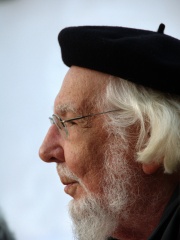
5. Ernesto Cardenal (1925 - 2020)
With an HPI of 66.74, Ernesto Cardenal is the 5th most famous Nicaraguan Politician. His biography has been translated into 35 different languages.
Ernesto Cardenal Martínez (20 January 1925 – 1 March 2020) was a Nicaraguan Catholic priest, poet, and politician. He was a liberation theologian and the founder of the primitivist art community in the Solentiname Islands, where he lived for more than ten years (1965–1977). A former member of the Nicaraguan Sandinistas, he was Nicaragua's minister of culture from 1979 to 1987. He was prohibited from administering the sacraments in 1984 by Pope John Paul II, but rehabilitated by Pope Francis in 2019.

6. Enrique Bolaños (1928 - 2021)
With an HPI of 63.86, Enrique Bolaños is the 6th most famous Nicaraguan Politician. His biography has been translated into 33 different languages.
Enrique José Bolaños Geyer (pronounced [enˈrike βoˈlaɲos]; 13 May 1928 – 14 June 2021) was a Nicaraguan politician who served as the president of Nicaragua from 10 January 2002 to 10 January 2007. From 1997 to 2002, Bolaños served as vice president under Arnoldo Alemán. On 4 November 2001 he defeated former president Daniel Ortega of the Sandinista National Liberation Front in the presidential election and was sworn in as president on 10 January 2002. He was a member of the Constitutional Liberal Party (PLC) until he broke with it to help form the Alliance for the Republic (APRE). At the beginning of his term as president, he led an anti-corruption campaign that ultimately convicted Alemán, his predecessor and head of the PLC, to 20 years in prison.

7. Luis Somoza Debayle (1922 - 1967)
With an HPI of 62.00, Luis Somoza Debayle is the 7th most famous Nicaraguan Politician. His biography has been translated into 25 different languages.
Luis Anastasio Somoza Debayle (18 November 1922 – 13 April 1967) was the 30th President of Nicaragua from 1957 until his resignation in 1963. He succeeded to the presidency following the death of his father, Anastasio Somoza García. The Somoza family was the most powerful family in the country at that time.

8. Arnoldo Alemán (b. 1946)
With an HPI of 61.32, Arnoldo Alemán is the 8th most famous Nicaraguan Politician. His biography has been translated into 28 different languages.
José Arnoldo Alemán Lacayo (born 23 January 1946) is a Nicaraguan politician who served as the president of Nicaragua from 10 January 1997 to 10 January 2002. In 2003, he was convicted of corruption and sentenced to a 20-year prison term; the conviction was overturned by the Supreme Court of Nicaragua in 2009.

9. José Santos Zelaya (1853 - 1919)
With an HPI of 58.16, José Santos Zelaya is the 9th most famous Nicaraguan Politician. His biography has been translated into 19 different languages.
José Santos Zelaya López (1 November 1853 – 17 May 1919) was the President of Nicaragua from 25 July 1893 to 21 December 1909. He was liberal. In 1909, Zelaya was ousted from office in a rebellion led by liberal Juan José Estrada who was aided by the U.S. government and Nicaraguan conservatives. The overthrow of Zelaya led to a civil war which was brought to an end with the U.S. occupation of Nicaragua in 1912.
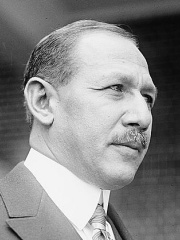
10. Emiliano Chamorro Vargas (1871 - 1966)
With an HPI of 57.77, Emiliano Chamorro Vargas is the 10th most famous Nicaraguan Politician. His biography has been translated into 18 different languages.
Emiliano Chamorro Vargas (11 May 1871 – 26 February 1966) was a Nicaraguan military figure and politician who served as President of Nicaragua from 1 January 1917 to 1 January 1921. He was a member of the Conservative Party. He lost the 1924 Nicaraguan general election. He launched a coup in 1925 against President Carlos José Solórzano. Chamorro was interim president from 14 March to 11 November 1926.
People
Pantheon has 17 people classified as Nicaraguan politicians born between 1853 and 1949. Of these 17, 2 (11.76%) of them are still alive today. The most famous living Nicaraguan politicians include Daniel Ortega, and Arnoldo Alemán. The most famous deceased Nicaraguan politicians include Anastasio Somoza Debayle, Anastasio Somoza García, and Violeta Chamorro.
Living Nicaraguan Politicians
Go to all RankingsDeceased Nicaraguan Politicians
Go to all RankingsAnastasio Somoza Debayle
1925 - 1980
HPI: 70.58
Anastasio Somoza García
1896 - 1956
HPI: 69.45
Violeta Chamorro
1929 - 2025
HPI: 68.69
Ernesto Cardenal
1925 - 2020
HPI: 66.74
Enrique Bolaños
1928 - 2021
HPI: 63.86
Luis Somoza Debayle
1922 - 1967
HPI: 62.00
José Santos Zelaya
1853 - 1919
HPI: 58.16
Emiliano Chamorro Vargas
1871 - 1966
HPI: 57.77
Juan Bautista Sacasa
1874 - 1946
HPI: 57.55
Edén Pastora
1936 - 2020
HPI: 57.47
José María Moncada
1870 - 1945
HPI: 55.96
Carlos José Solórzano
1860 - 1936
HPI: 55.48
Overlapping Lives
Which Politicians were alive at the same time? This visualization shows the lifespans of the 13 most globally memorable Politicians since 1700.

